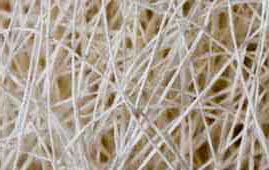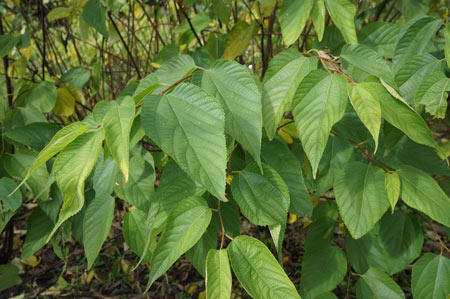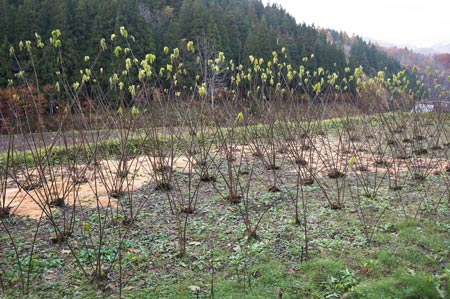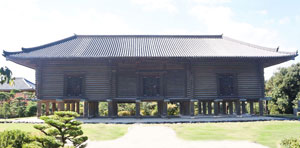From Washi, Kami-ito to Shifu 和紙そして紙糸から紙布に

Home Page
Website update
Hello everyone, this time we changed our website structure. Previously, we used mixture of Japanese and English on a same page. But those are now on separate pages that might help you to see and read easier than before.
Kozo
The first article is "Kozo" that is the material of "Washi" (Japanese handmade paper).
 Kami-ito (paper thread) made from kozo washi.
Kami-ito (paper thread) made from kozo washi.
 Common kozo leaves
Common kozo leaves
Kozo (Scientific name : Broussonetia kazinoki × Broussonetia papyrifera)
The main materials for Japanese handmade paper are kozo, mitsumata, and ganpi. Among them, the best material for making paper thread is kozo paper.
Kozo has a simple leaf with notchs in the leaf blade like this photo. This is a typical kozo leaves.
However, some kozo has an ordinary simple leaf without a notch in the leaf blade like egg shape. This is also kozo leaves.
 Egg shaped kozo leaves
Egg shaped kozo leaves
Kozo is a plant of the Moraceae family, and is said to be a hybrid plant. Like other Moraceae family, the shape of the kozo leaves varies depending on species, location and environment. Also many young trees are notched, and as the trees get older, the leaves become smaller and become distorted oval.
It is a little difficult to identify the kozo with the leaves from other Moraceae family.
Generally, Paper Mulberry is used in English for kozo name. Kozo is a deciduous shrub with broad simple leaves and a height of 2-5 m. The trunk diameter grows up to about 20 cm, and the bark is brown. The leaves alternate with short stalks. It is growing naturally throughout Japan (except the northern part), Taiwan, Korea, and central and southern China.
 Kozo field in summer, branches are growing steadily (At Gifu-prefecture Hida-city Kawai-cho, Mr. Tadao Shimizu's kozo field on June 2018)
Kozo field in summer, branches are growing steadily (At Gifu-prefecture Hida-city Kawai-cho, Mr. Tadao Shimizu's kozo field on June 2018)
Harvest
Kozo is cultivated many ares of Japan. In autumn, all stalks are cut from the stumps for harvesting.
Some small and some good grown about 4 meters tall stalks are collected every years from the same stumps for about 30 years.
Right after the harvest, the white inner barks are peeled off from the stalks as a material of washi.
The fibers of the kozo bark are longer than those of mitsumata and ganpi.
Tough fibers entangle and stick each other to form a strong Japanese handmade paper.
 Kozo field in autumn, waiting for harves (At Gifu-prefecture Hida-city Kawai-cho, Mr. Tadao Shimizu's kozo field on November 2017)
Kozo field in autumn, waiting for harves (At Gifu-prefecture Hida-city Kawai-cho, Mr. Tadao Shimizu's kozo field on November 2017)
History
Durable, clean and long lasting washi will be made with many preparatory stages and hard work. Paper making process seems to have been going on everywhere in Japan for over 1000 years. In fact, there is paper left for 1000 years.
The Shosoin* treasure is indispensable part of Japanese paper history. There is a family register of Mino, Chikuzen, and Buzen provinces in 702 as a Japanese handmade kozo paper that has been handed down for more than 1000 years.
 Shosoin
Shosoin
Shosoin* : The exact construction date is unclear, but it definitely was finished before AD 759.
Since the Shōsō-in was to be a repository for (valuable) objects, it today holds around 9,000 items. Ninety-five percent of the fine arts and crafts in the Shōsōin were produced in Japan around the 8th Century, with the remainder imported from the Tang Dynasty, Central Asia, India, Iran, etc. during the same period. (Excerpted from Wikipedia, the free encyclopedia)